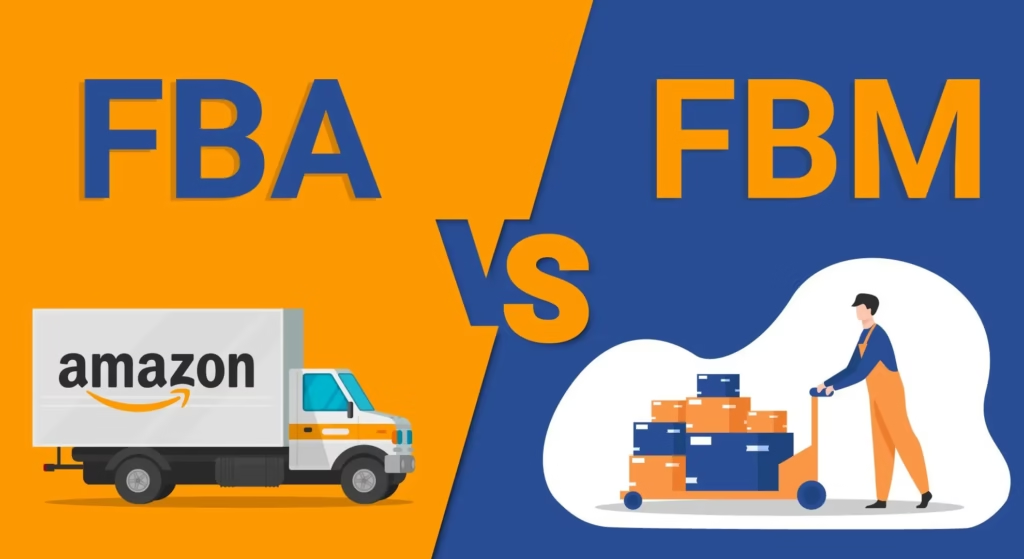In cross-border e-commerce, the choice of fulfillment model directly determines your cost structure, customer experience, and profit margins. On Amazon, the two most common fulfillment methods are:
- FBA (Fulfillment by Amazon)
- FBM (Fulfillment by Merchant)
At first glance, the difference seems simple—who ships the product. But behind that lies a complex web of traffic weight, cost control, inventory management, and customer trust. This guide will help you understand the relationship, differences, use cases, and characteristics of FBA and FBM, with updated 2025 data and case studies.
The Relationship Between FBA and FBM
- FBA: Sellers ship inventory to Amazon’s warehouses. Amazon handles storage, picking, packing, shipping, and returns.
- FBM: Sellers (or third-party logistics providers) handle storage, packaging, and shipping themselves.
They are not opposites but complementary models. Many experienced sellers adopt a hybrid strategy (FBA + FBM) to balance cost, efficiency, and risk.
Key Differences Between FBA and FBM
| Dimension | FBA (Fulfillment by Amazon) | FBM (Fulfillment by Merchant) |
|---|---|---|
| Delivery Speed | Prime 1–2 days | 3–7 days (overseas warehouse) or longer (direct shipping) |
| Fulfillment Cost | Higher (storage + fulfillment fees) | Lower (self-controlled logistics) |
| Traffic Weight | Prime badge, higher Buy Box eligibility | No Prime badge, must compete on price/reviews |
| Inventory Management | Amazon manages | Seller manages (flexible but complex) |
| Customer Trust | High (Amazon-backed) | Lower (depends on seller ratings) |
| Best For | Small/light, fast-moving products | Large/heavy, low-volume, customized products |
FBA: Features and Use Cases
Advantages
- Traffic & Conversion Boost
- Prime badge increases conversion by 30–50% (Amazon 2024 report).
- Eligible for Prime Day, Black Friday promotions.
- Simplified Operations
- Amazon handles logistics and returns, freeing sellers to focus on sourcing and marketing.
- Superior Customer Experience
- Fast shipping and easy returns improve repeat purchase rates.
Disadvantages
- Higher costs: long-term storage fee (over 365 days) is $6.90/ft³ per month.
- Inventory risk: unsold stock incurs removal or disposal fees.
- Less flexibility: no custom packaging or inserts.
Best Use Cases
- New product launches (boost ranking quickly).
- High-turnover products (100+ units/month).
- Lightweight, small items (e.g., phone cases, daily essentials).
FBM: Features and Use Cases
Advantages
- Cost Flexibility
- No Amazon storage fees.
- Better for low-volume or seasonal products.
- Customization
- Add inserts, gifts, or branded packaging.
- Ideal for personalized or handmade items.
- Lower Inventory Risk
- Stock on demand, faster cash flow.
Disadvantages
- Slower delivery: direct shipping may take 10–20 days.
- More complex operations: seller must manage logistics and returns.
- Traffic disadvantage: no Prime badge, higher CPC ad costs (20–30% more than FBA).
Best Use Cases
- Large/heavy items (furniture, gym equipment).
- Customized products (engraved jewelry, print-on-demand).
- Test products (avoid FBA overstock risk).
Hybrid Strategy (FBA + FBM)
Product Segmentation
- FBA for bestsellers and high-volume SKUs.
- FBM for long-tail or bulky items.
Seasonal Adjustment
- Peak season (Q4): rely on FBA for speed.
- Off-season: shift some SKUs to FBM to reduce storage fees.
Risk Mitigation
- Use FBM as backup when FBA runs out of stock.
2025 Data & Case Studies
Case 1: Lightweight Phone Cases (100 units)
- FBA: $0.5 shipping + $3.07 fulfillment + $0.1 storage = $367 total
- FBM: $0.5 shipping + $4.5 delivery = $500 total
- FBA saves 26%.
Case 2: Gym Benches (50 units)
- FBA: $15 shipping + $45 fulfillment + $2 storage = $3,100 total
- FBM: $15 shipping + $30 delivery = $2,250 total
- FBM saves 27%.
Extended Topics for amazon Sellers
Rise of Third-Party Overseas Warehouses
- FBM sellers can leverage local warehouses for 2–5 day delivery.
Advertising & Traffic
- FBA listings enjoy lower CPC and higher ROI.
- FBM sellers must rely more on external traffic and branding.
Compliance & Taxation
- FBA: storing goods in EU warehouses triggers VAT obligations in multiple countries.
- FBM: usually only subject to distance selling thresholds.
Conclusion
- FBA: Best for sellers seeking traffic, conversion, and customer trust—especially for small/light, fast-moving products.
- FBM: Best for sellers prioritizing cost control, flexibility, and customization—especially for bulky, low-volume, or niche products.
- Hybrid (FBA + FBM): The optimal strategy for mature sellers, balancing growth and risk.
Ultimately, the choice depends on product type, capital strength, and business goals.
Popular FBA FBM Q&A
more read: Everything You Need to Know About the EU FBA Guide
A Guide to China’s Top 5 Airports 2025
Soaring Through the Middle Kingdom: A Guide to China’s Top 5 Airports 2025, China’s meteoric…
The Ultimate Guide to Sourcing & Shipping Christmas Ornaments from China
The Ultimate Guide to Sourcing & Shipping Christmas Ornaments from China. The holiday season is…
Decoding Shunde: The Ultimate Guide to the World’s Appliance Capital
Decoding Shunde, If you’ve ever turned on a microwave, blended a smoothie, or adjusted your…




